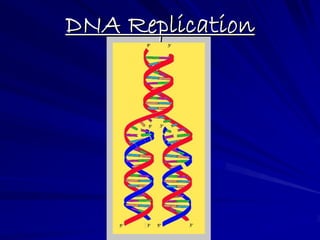Dna replication
- 2. DNA ReplicationDNA Replication Replication = DNA copies itselfReplication = DNA copies itself exactlyexactly (Occurs within the nucleus)(Occurs within the nucleus) Any mistake in copying =Any mistake in copying = mutationmutation DNA mutation = chromosomal mutationDNA mutation = chromosomal mutation
- 3. A. Basic Facts of DNAA. Basic Facts of DNA ReplicationReplication 1.1. ComplementaryComplementary base pairingbase pairing makesmakes replication possiblereplication possible CC -- GG AA -- TT
- 4. A. Basic Facts of DNAA. Basic Facts of DNA ReplicationReplication 2. One side of DNA2. One side of DNA molecule ismolecule is aa templatetemplate forfor makingmaking thethe other sideother side (strand)(strand) ?âs 1-3
- 5. B. Process of DNA ReplicationB. Process of DNA Replication 1.1. Uncoil & unzip DNA moleculeUncoil & unzip DNA molecule Enzyme (Enzyme (--asease)) breaksbreaks weakweak Hydrogen BondHydrogen Bond between basesbetween bases
- 6. B. Process of DNA ReplicationB. Process of DNA Replication 2.2. Enzyme brings in complementary NEnzyme brings in complementary N--basesbases DNA Polymerase
- 7. B. Process of DNA ReplicationB. Process of DNA Replication 3.3. Insert NInsert N--basesbases DNA Replication TutorialDNA Replication Tutorial (Go here for on(Go here for on--youryour--own learning/review)own learning/review) trc.ucdavis.edu/.../week5/06dnareplication.html
- 8. ReplicationReplication MoovieMoovie CC -- GG AA -- TT
- 9. C.C. SemiSemi--conservative replicationconservative replication 1.1. Each new DNAEach new DNA moleculemolecule containscontains one old strandone old strand && one new strandone new strand ?âs 4-6
- 11. DNA vs. RNADNA vs. RNA DNADNA RNARNA Sugar =Sugar = deoxyribosedeoxyribose Sugar =Sugar = riboseribose DoubleDouble--strandedstranded moleculemolecule SingleSingle--strandedstranded moleculemolecule ThymineThymine bonds withbonds with adenineadenine UracilUracil instead of thymineinstead of thymine
- 12. DNA vs. RNADNA vs. RNA DNADNA RNARNA NuclearNuclear DNADNA MitochondrialMitochondrial DNADNA ChloroplastChloroplast DNADNA mRNAmRNA = messenger= messenger tRNAtRNA = transfer= transfer rRNArRNA = ribosomal= ribosomal Nuclear DNANuclear DNA nevernever leaves the nucleusleaves the nucleus Assembled in nucleus,Assembled in nucleus, moves to cytoplasmmoves to cytoplasm ((leaves the nucleusleaves the nucleus))
- 13. DNADNA vs.vs. RNARNA ?âs 7-12













